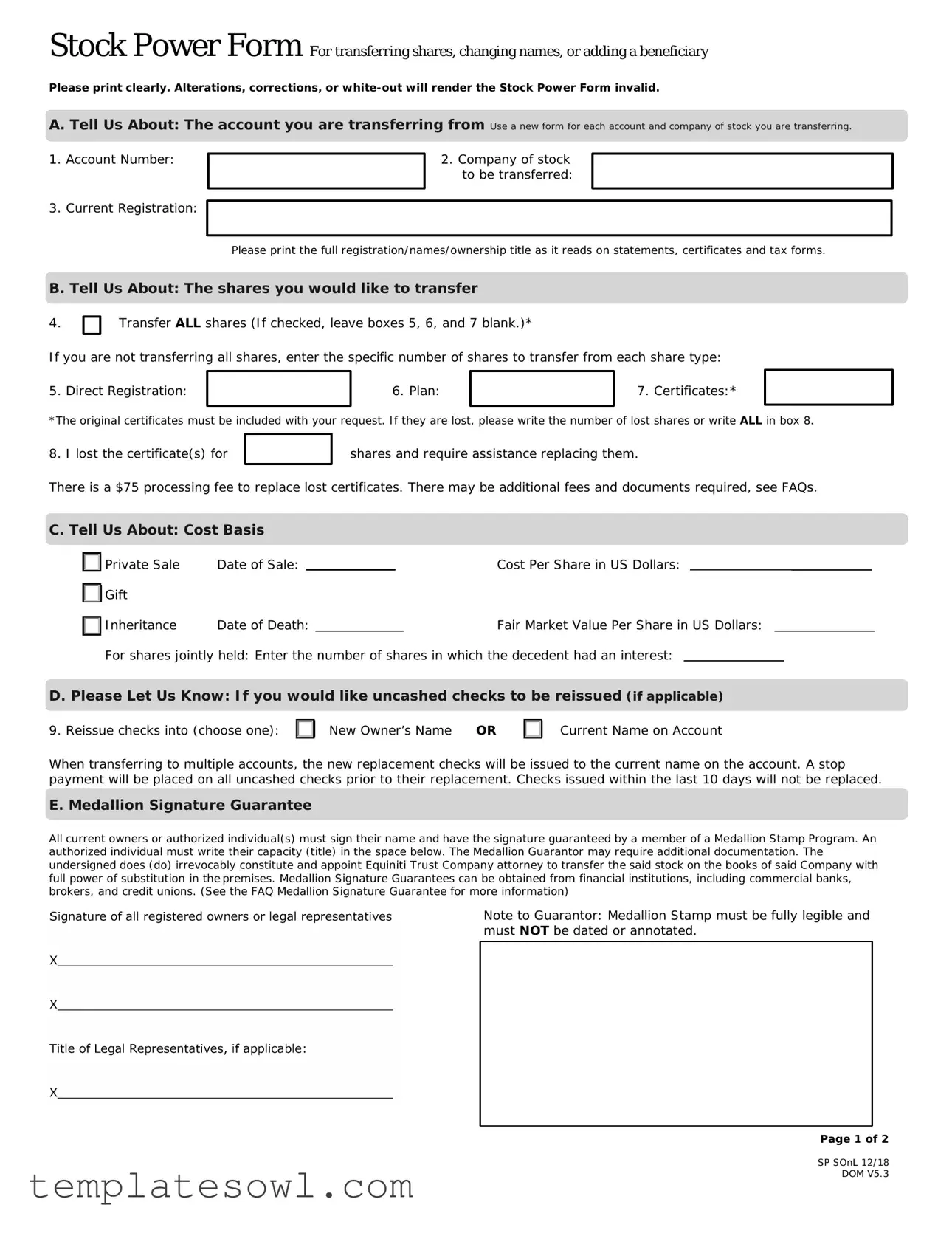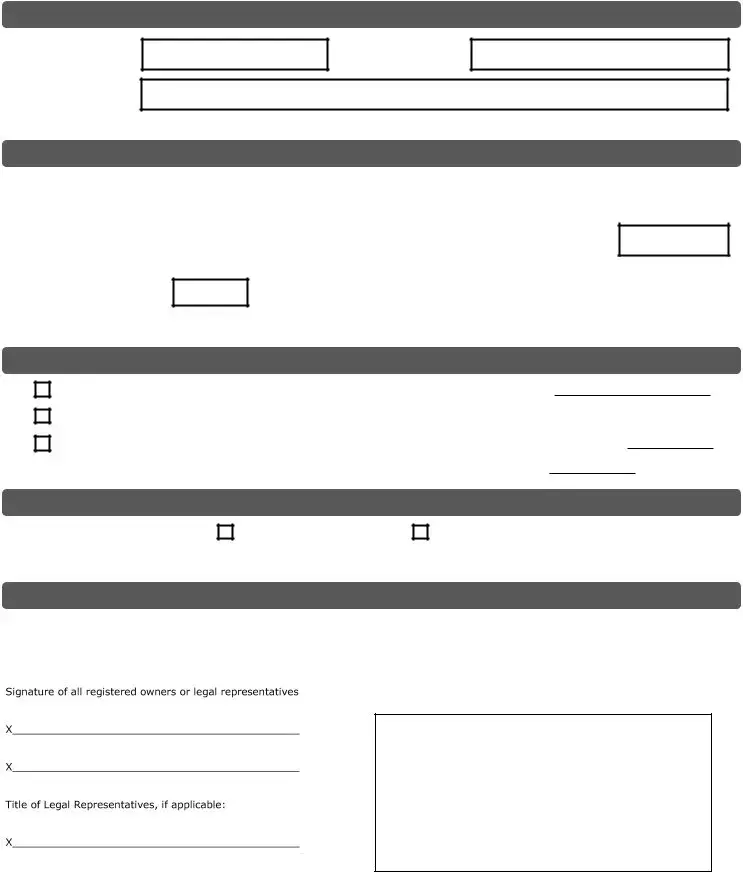A. Tell Us About: The account you are transferring from
1.Enter the 10 digit account number for the current account.
2.Enter the name of the company of stock to be transferred. A separate Stock Power Form is needed for each account and company of stock you are transferring.
3.List the current registration names/ownership title as it reads on statements, certificates and tax forms.
B. Tell Us About: The shares you would like to transfer
4.Check the first box only if you are transferring all shares. If checked, leave boxes 5, 6, and 7 blank.
If you are not transferring all shares, enter the specific number of shares to transfer from each share type into boxes 5, 6, or 7 as needed:
5.Enter the number of Direct Registration shares being transferred or leave blank. These shares are held electronically.
6.Enter the number of Plan shares being transferred or leave blank. These shares are held electronically.
7.Enter the number of certificate shares being transferred or leave blank. These shares have been issued as paper stock certificates. Original stock certificate(s) must be mailed with your Stock Power Form.
8.Enter the number of lost certificate shares or write ALL in box 8. If this does not apply, leave blank. There is a $75 processing fee to replace lost certificates. There may be additional fees and documents required.
C. Tell Us About: Cost Basis
See the enclosed “Frequently Asked Questions about Cost Basis” for further information.
Please check the box next to the purpose of the transfer. We recommend that you consult with your tax advisor regarding the tax implications for each type of transfer.
•Private Sale: Include the Date of Sale and the Cost Per Share.
•Gift: Select this box if gifting shares, the gift date will default to the date that the transfer is processed.
•Inheritance: Include the Date of Death and Fair Market
Value Cost per Share. For shares jointly held: Enter the number of shares or percentage of shares in which the decedent had an interest.
D. Please Let Us Know: If you would like uncashed checks to be reissued
9.Check only one box. If the shares are going to multiple new owners, the checks must be reissued into the current name on the account.
E. Medallion Signature Guarantee
All owners must sign their name and have their signature guaranteed in the medallion format.
If an owner is unable to sign, a legal representative such as a Power of Attorney, Custodian, or Successor Trustee may sign on behalf of the shareowner. List the title of the legal representative below their signature. Medallion Signature Guarantees can be obtained from financial institutions, including commercial banks, brokers, and credit unions.
Where to get a medallion signature guarantee stamp?
We have entered into an arrangement for US shareholders to
obtain a medallion signature guarantee via an online platform at www.eSignatureGuarantee.com
1.Go to the website eSignatureGuarantee.com
2.Have your ID validated (no prior account required)
3.Use promo code EQ to receive a discount on the medallion signature guarantee purchase
Please note that there is a $500,000 limit on the value of transactions that eSignatureGuarantee.com is able to guarantee. For more information email info@eSignatureGuarantee.com
F. Tell Us About: The account you want the shares transferred to
If you are transferring to multiple accounts, enter the number of shares to transfer into the account indicated on this page.
If you are transferring to an existing account, enter the 10 digit account number and complete Line 1. with the full account registration. Then, skip to Section H.
Registration for the New Account:
Check only one box to indicate the type of registration and complete the indicated lines, new address, and Tax ID.
We recommend using capital letters when completing section F to avoid registration and spelling errors, (e.g., JOHN A DOE).
Line 1. Enter the name of the New Owner, Custodian, Trustee, Executor, or Other name (First Name, Middle Initial, Last Name). This should match the name shown on the income tax return filed with the IRS.
Line 2a. If applicable, enter the Joint Owner, Minor, Second Trustee, or Other name (First Name, Middle Initial, Last Name). This should match the name shown on the income tax return filed with the IRS.
Line 2b. If applicable, enter Minor’s state of residence.
Line 3. If applicable, enter any additional Joint Owner, Trustee, or Other name (First Name, Middle Initial, Last Name). This should match the name shown on the income tax return filed with the IRS.
Line 4a. If applicable, enter Name of Trust, Estate name, or the TOD Beneficiary’s name. Only one TOD Beneficiary is allowed per account. This should match the name shown on the income tax return filed with the IRS.
Line 4b. If applicable, enter the date of the Trust.
Address for the New Account:
Enter full mailing address including City, State, and Zip Code.
Tax ID for the New Account:
Enter the 9 digit Social Security Number (SSN) or Employer Identification Number (EIN) for the new account and then check the applicable box. If there are multiple owners, enter the number you would like the income reported under. Only one number is allowed per account. If Custodian for Minor is selected, enter the Minor’s Social Security Number (SSN).
G. Substitute Form W-9
The new owner, whose SSN or EIN is listed in the Tax ID for the New Account box, must sign and date this section.
H. Please Let Us Know: if the new owner would like to receive instructions for online access
Check the box to request instructions sent to the new owner. The necessary information will be mailed to the address provided in Section F.




